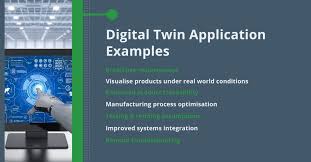The Power of Digital Twin Technology
Technology has always aimed to bridge the gap between the physical and digital worlds. With the advent of digital twin technology, this gap is being narrowed like never before. Digital twin technology is revolutionizing industries across the board, from manufacturing and healthcare to transportation and urban planning.
What is a Digital Twin?
A digital twin refers to a virtual replica or simulation of a physical object, process, or system. It is created by combining real-time data from sensors, IoT devices, and other sources with advanced analytics and modeling techniques. This enables organizations to monitor, analyze, and optimize performance in real-time.
Applications of Digital Twin Technology
Manufacturing: In manufacturing industries, digital twins are used to simulate production processes, identify bottlenecks, optimize workflows, and predict maintenance needs. By creating virtual replicas of machines or entire factories, manufacturers can reduce downtime, improve efficiency, and enhance overall productivity.
Healthcare: Digital twins have immense potential in healthcare. They can be used to create personalized patient models that help doctors visualize diseases or conditions more accurately. This enables better diagnosis and treatment planning. Additionally, digital twins can simulate drug interactions or surgical procedures before they are performed on actual patients.
Transportation: The transportation sector can benefit greatly from digital twins. For example, in aviation, digital twins can monitor aircraft performance in real-time and predict maintenance needs proactively. In smart cities, digital twins can simulate traffic patterns and optimize public transportation routes for improved efficiency.
The Benefits
Digital twin technology offers several key benefits:
- Improved Efficiency: By monitoring and analyzing real-time data, organizations can identify inefficiencies and make data-driven decisions to optimize performance.
- Predictive Maintenance: Digital twins enable predictive maintenance, reducing downtime and saving costs by identifying potential issues before they occur.
- Enhanced Innovation: Digital twins provide a platform for experimentation and innovation without the need for physical prototypes, enabling faster development cycles.
- Cost Savings: By optimizing processes and reducing downtime, organizations can save costs in various areas, including maintenance, energy consumption, and resource allocation.
The Future of Digital Twin Technology
The potential of digital twin technology is vast and continues to expand. As advancements in IoT, artificial intelligence, and cloud computing continue to evolve, digital twins will become even more sophisticated. They will play a crucial role in shaping smart cities, improving sustainability efforts, enhancing healthcare outcomes, and driving overall efficiency across industries.
In conclusion, digital twin technology is transforming the way we interact with the physical world. By creating virtual replicas that mirror real-world objects or processes, organizations can gain valuable insights, optimize performance, and drive innovation. With its wide-ranging applications and numerous benefits, digital twin technology is set to revolutionize industries for years to come.
“Decoding Digital Twins: Understanding the Technology’s Fundamentals”
3. “Bringing Concepts to Life: A Real-World Example of Digital Twin Application
- Why use digital twin technology?
- What is a digital twin technology?
- What is an example of a digital twin?
- Is digital twin an emerging technology?
Why use digital twin technology?
Digital twin technology offers numerous advantages that make it a valuable tool across various industries. Firstly, it enables organizations to gain real-time insights into the performance and behavior of physical assets or processes, allowing for proactive decision-making and optimization. By creating virtual replicas, organizations can simulate different scenarios, test hypotheses, and identify potential issues before they occur in the real world. This helps in reducing downtime, enhancing operational efficiency, and improving overall productivity. Additionally, digital twins facilitate predictive maintenance by monitoring data from sensors and IoT devices, enabling organizations to detect anomalies and schedule maintenance activities proactively. Furthermore, digital twin technology fosters innovation by providing a platform for experimentation without the need for costly physical prototypes. Overall, the use of digital twin technology empowers organizations to make data-driven decisions, optimize processes, reduce costs, and drive continuous improvement in various domains.
What is a digital twin technology?
Digital twin technology refers to the creation of a virtual replica or simulation of a physical object, process, or system. By combining real-time data from sensors, IoT devices, and other sources with advanced analytics and modeling techniques, digital twins enable organizations to monitor, analyze, and optimize performance in real-time. It provides a powerful tool for industries such as manufacturing, healthcare, transportation, and urban planning to simulate and understand their physical assets more comprehensively. With its ability to bridge the gap between the physical and digital worlds, digital twin technology is revolutionizing how organizations operate and make data-driven decisions.
What is an example of a digital twin?
An example of a digital twin is in the field of aviation. Aircraft manufacturers and operators are utilizing digital twins to create virtual replicas of their aircraft. These digital twins incorporate real-time data from sensors installed on the actual aircraft, allowing for continuous monitoring and analysis of its performance. By simulating various flight scenarios, maintenance needs can be predicted, potential issues can be identified, and operational efficiency can be improved. Digital twins in aviation enable proactive maintenance planning, reducing downtime and enhancing overall safety and reliability in the industry.
Is digital twin an emerging technology?
Yes, digital twin technology is considered an emerging technology. While the concept of digital twins has been around for several years, advancements in IoT, data analytics, and cloud computing have enabled its widespread adoption and practical implementation. Industries are increasingly recognizing the value of digital twins in improving operational efficiency, optimizing processes, and making data-driven decisions. As organizations continue to explore the potential applications and benefits of digital twin technology, it is expected to become even more prevalent in various sectors, solidifying its status as an emerging technology with immense potential for innovation and growth.
Tags: advantages, anomalies detection, behavior, costly physical prototypes, digital twin technology, experimentation, innovation platform, iot devices, monitoring data, operational efficiency, optimization, performance, potential issues, predictive maintenance, proactive decision-making, productivity, real-time insights, reducing downtime, schedule maintenance activities proactively, sensors, simulate scenarios, test hypotheses, virtual replicas
